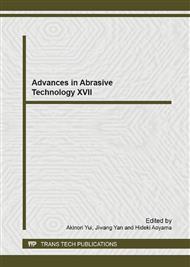p.249
p.255
p.261
p.267
p.273
p.281
p.287
p.292
p.298
Investigation on Properties of Magnesia Grinding Wheels Used in Silicon Wafer Grinding
Abstract:
This paper presents the results of an experimental investigation on molar ratios of MgO/ MgCl2 affecting the hardness of magnesia grinding wheels, which is one of the most important properties. Magnesite grinding blocks of different ratios of MgO/MgCl2 were prepared. The surface Rockwell hardness of which was tested under the same curing conditions. By an integrated assessment of the experimental studies of hardness and component, it is recognized that the molar ratios of MgO/MgCl2 can significantly affect the properties of magnesia grinding wheels. With the increase of MgO/MgCl2 molar ratio, hardness of the specimens increases. Scanning electron microscopy (SEM) studies on grinding blocks of different ratios indicated that micro needle shaped crystal structure of phase 5 are mainly responsible for hardness development. Finally the optimal recipe was selected in consideration of the characteristics of the silicon mechanical chemical grinding (MCG), which was verified to be effective by the following grinding experiment.
Info:
Periodical:
Pages:
273-278
Citation:
Online since:
September 2014
Authors:
Keywords:
Price:
Сopyright:
© 2014 Trans Tech Publications Ltd. All Rights Reserved
Share:
Citation:


